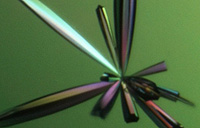
The United Nations Educational, Scientific and Cultural Organization (UNESCO) has declared 2014 as the International Year of Crystallography. The International Year of Crystallography 2014 (IYCr2014) celebrates the centennial of X-ray diffraction and the 400th anniversary of Kepler’s observation of the symmetrical form of ice crystals. This year also commemorates the 50th anniversary of the Nobel Prize awarded to Dorothy Hodgkin for her work on vitamin B12 and penicillin, also via X-ray crystallography.
York chemistry Professor Gerald Audette, who holds a PhD in X-ray crystallography and is a strong advocate of the science, notes that this method pervades almost every field of the natural sciences.
“X-ray crystallography is central to most science these days, but is really an un-sung hero,” said Audette. “Crystallography has been a part of at least one Nobel Prize every year between 2009 and 2013 and it has been making major contributions to science for over a hundred years as recognized by 48 distinct Nobel prizes.” Audette will be presenting his team’s research at the annual meeting of the American Crystallographic Association in May, and at the 23rd International Union of Crystallography (IUCr) General Congress being held in August in Montreal.
X-ray crystallography is a tool used for determining the atomic and molecular structure of a crystal, in which the crystalline atoms cause a beam of incident X-rays to diffract into many specific directions. By measuring the angles and intensities of these diffracted beams, a crystallographer can produce a three-dimensional picture of the density of electrons within the crystal.
Professor Vivian Saridakis, who also holds a PhD in X-ray crystallography, similarly described the importance of crystallography in our daily lives. “Crystallography is very important in understanding diseases and in the development of new therapeutic drugs. It permits the determination of the atomic structure of proteins and nucleic acids leading to an understanding of their biological functions, why alterations in their structure lead to disease and how drugs can affect their function,” said Saridakis. She will also be attending the IUCr General Congress being held in Montreal.
 According to the official IYCr2014 website, the International Year of Crystallography highlights significant crystallography achievements, and stresses the importance of crystallography and its role in addressing post-2015 development issues such as food security, health care, safe drinking water, sustainable energy and environmental remediation.
According to the official IYCr2014 website, the International Year of Crystallography highlights significant crystallography achievements, and stresses the importance of crystallography and its role in addressing post-2015 development issues such as food security, health care, safe drinking water, sustainable energy and environmental remediation.
The main objectives of the IYCr2014 are to increase public awareness of the science of crystallography and how it permeates most technological developments in our modern society, and to encourage young people through public exhibitions, conferences and demonstrations in schools.
For further information, visit the IYCr2014 website or UNESCO’s event page.


